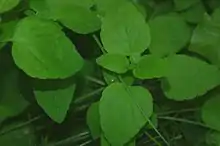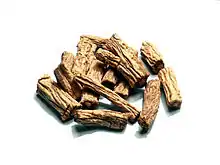Codonopsis pilosula
Codonopsis pilosula, also known as Dangshen (Chinese: 党参; pinyin: Dǎngshēn), is a perennial species of flowering plant in the bellflower family. It is native to Asia, where it grows in forests, meadows, and scrub.[1]
| Wikimedia Commons has media related to Codonopsis pilosula. |
| Codonopsis pilosula | |
|---|---|
 | |
| Scientific classification | |
| Kingdom: | Plantae |
| Clade: | Tracheophytes |
| Clade: | Angiosperms |
| Clade: | Eudicots |
| Clade: | Asterids |
| Order: | Asterales |
| Family: | Campanulaceae |
| Genus: | Codonopsis |
| Species: | C. pilosula |
| Binomial name | |
| Codonopsis pilosula | |
Description
The plant produces twining stems up to 2 m (6.6 ft) long. It has lateral branches with alternately arranged leaves and small branchlets with oppositely arranged leaves. The ovate leaves are up to 7.3 cm (3 in) centimeters long and are usually coated with short hairs. Solitary flowers occur at the branch tips. The bell-shaped flower is about 2 cm (0.8 in) long and wide and is yellow-green with purple spots inside. The fruit capsule is up to 2.4 cm (0.9 in) long.[1]
Uses
Traditional


The roots of C. pilosula are used in traditional Chinese medicine. They are carrot-shaped or cylindrical, sometimes branched, and up to 30 cm (12 in) long by 3 cm (1.2 in) wide.[1] They are a constituent of Radix Codonopsis, a mixture used in herbal medicine.[2]
Medicinal
The traditional medicinal use of Dangshen has inspired medical studies investigating the root's capabilities to treat cardiovascular, pulmonary and digestive conditions. Research into the effect of Condonopsis pilosula extract on gastric ulcers in rats showed a reduction in gastric acid production and severity of stress induced ulcers. [3]
Subspecies
There are 3 subspecies:[1]
References
- Codonopsis pilosula. Flora of China.
- Li, C. Y; Xu, H. X; Han, Q. B; Wu, T. S (2009). "Quality assessment of Radix Codonopsis by quantitative nuclear magnetic resonance". Journal of Chromatography A. 1216 (11): 2124–9. doi:10.1016/j.chroma.2008.10.080. PMID 19004445.
- Wang, Z.-T.; Du, Q.; Xu, G.-J.; Wang, R.-J.; Fu, D.-Z.; Ng, T.-B. (1997). "Investigations on the Protective Action of Condonopsis pilosula (Dangshen) Extract on Experimentally-Induced Gastric Ulcer in Rats". General Pharmacology: The Vascular System. 28 (3): 469–473. doi:10.1016/s0306-3623(96)00047-x.
External links
- Wang ZT, Ng TB, Yeung HW, Xu GJ (December 1996). "Immunomodulatory effect of a polysaccharide-enriched preparation of Codonopsis pilosula roots". Gen. Pharmacol. 27 (8): 1347–50. doi:10.1016/s0306-3623(96)00084-5. PMID 9304404.
- Codonopsis Plants, National Council for The Conservation of Plants and Gardens